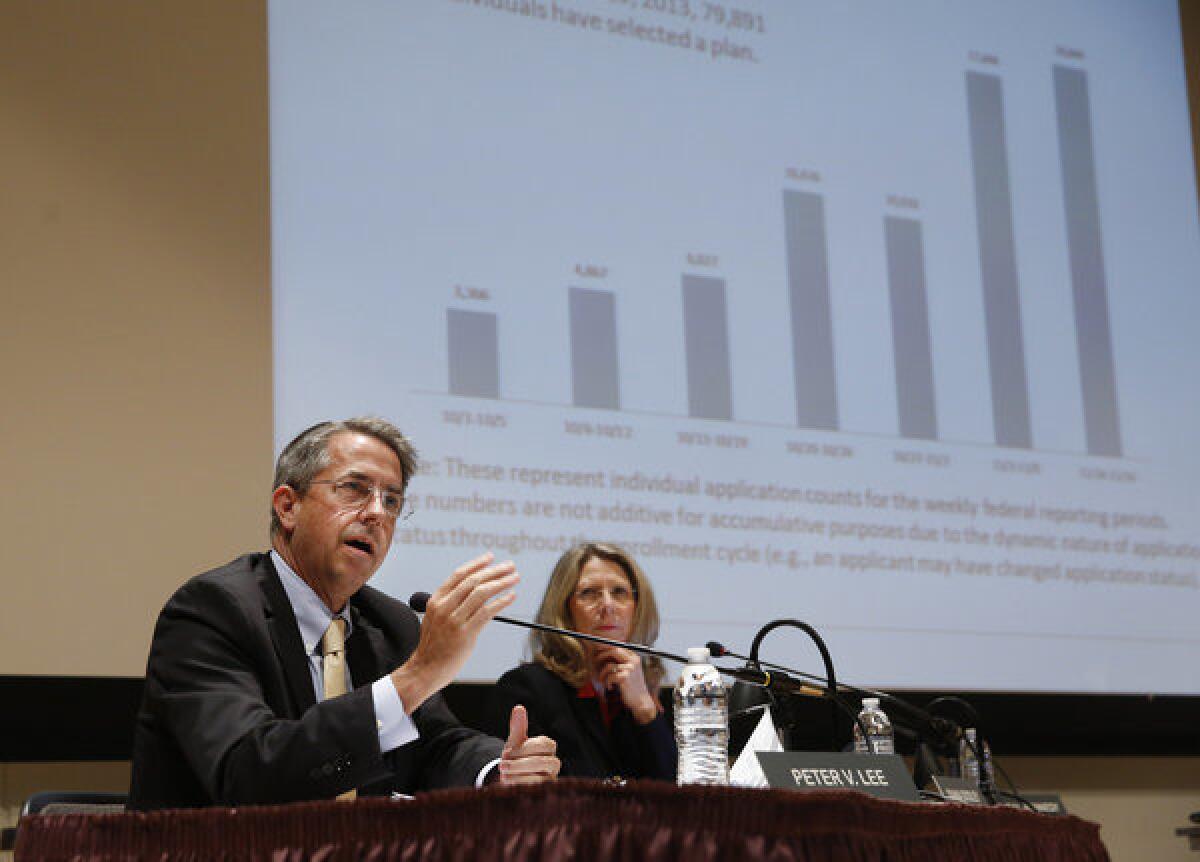Covered California to President Obama: Sorry, no

- Share via
This post has been updated, as explained below.
Defying President Obama, the board of directors for the state’s new health insurance exchange, Covered California, voted unanimously Thursday not to allow the 11 insurers that are selling plans on the exchange to revive their canceled policies.
Meanwhile, new statistics emerged that shed more light on the people losing their policies and the ones signing up through the exchange.
The board’s decision not to allow the policies was the right policy decision, no matter how much blowback it generates. As I’ve written several times in recent weeks, the 2010 Patient Protection and Affordable Care Act created minimum standards for insurance policies (exempting those that predated the act) to do two good things: eliminate policies that left their owners vulnerable to bankruptcy if they suffered a major illness or injury, and spread risks and costs broadly across the market for individual coverage.
PHOTO ESSAY: Obamacare -- and 8 other bungled launches
Although the law states that noncompliant policies could not be offered after Dec. 31, President Obama unilaterally declared that canceled policies could be revived for an additional year. That’s just punting the cancellations into next year, which is pointless. And it was a largely meaningless gesture in California, where the exchange’s contracts with insurers required them to stop offering noncompliant coverage at the end of this year. (Insurance Commissioner Dave Jones has ordered two carriers to continue offering canceled policies through the first few months of 2014, saying they failed to give policyholders the advance notice required by state law.)
Instead of changing those contracts, the Covered California board agreed Thursday to provide more information directly to state residents whose policies had been canceled, as well as more time to sign up for coverage. Specifically, the board pushed back from Dec. 15 to Dec. 23 the deadline for obtaining coverage that will go into effect right on Jan. 1. It also agreed to collect and report data regularly about the effect of the cancellations.
More than 1 million Californians had their policies canceled, but it’s not clear how many of them will be worse off as a consequence. A study released Thursday by Families USA -- a supporter of the ACA -- estimates that almost 70% of the Californians who obtain individual coverage (that is, their insurance isn’t provided by their employer) are eligible for subsidies through Covered California or Medi-Cal. The study also found that more than half of the people who obtain individual coverage (that is, their insurance isn’t provided by their employer) hold policies for less than a year, usually because they land a job with health benefits.
Combining those numbers, Families USA estimated that less than 1% of all Californians are expected to stay in the market for individual coverage for more than a year but won’t be eligible for subsidies. That’s a small percentage, but it translates into more than a quarter of a million people, or more than the population of Irvine.
The state exchange enrolled a fewer than 37,000 people in its first month of operation, counting every person covered (the number of new policies obtained is closer to 20,500). Covered California released a breakdown of its enrollees Thursday, revealing that a third of the enrollees were between the ages of 55 and 64. By way of comparison, that age group makes up only 11% of the state’s population. A disproportionate number were between the ages of 45 and 54 too; that group constituted 22% of the enrollees but is only 14% of the population. The only group that was underrepresented was minors, which suggests that comparatively few families signed up for individual coverage.
[Update, 6:50 a.m. Nov. 22: Andrew Wright of Health Access, a consumer advocacy group, said many children whose parents are enrolling in Covered California are being signed up instead for Medi-Cal. When it phased out its Healthy Families program, the state extended Medi-Cal coverage to children in families with incomes up to 250% of the federal poverty level, even though their parents were eligible only if their incomes were no more than 138% of that amount.]
Critics of Obamacare may leap to the conclusion that the exchange is doomed to failure because its customer base is skewing toward older and presumably less healthy people. That may ultimately prove to be true, but let’s not read too much into the early numbers. The market for individual coverage has a disproportionate share of older people too -- nationally, about 30% of the market is between the ages of 55 and 64, according to the Kaiser Family Foundation.
In addition, the coverage and prices offered by the exchanges are particularly attractive to people in that age group, Kaiser’s Karen Pollitz said. That’s because most of them are eligible for subsidies (because they earn less than four times the federal poverty level), and the new standards don’t allow insurers to charge as great a markup for older people as they had been doing. Of course, that means younger people wind up paying more to make up the difference.
If Massachusetts’ experience with healthcare reform is any guide, the last people to sign up will be the ones who need insurance the least. That’s not to say they’ll do so in California too, it’s just to argue that December’s statistics from Covered California will be more meaningful than October’s.
ALSO:
Why Netanyahu won’t yield
Harry Reid busts the filibuster
Follow Jon Healey on Twitter @jcahealey and Google+
More to Read
A cure for the common opinion
Get thought-provoking perspectives with our weekly newsletter.
You may occasionally receive promotional content from the Los Angeles Times.







